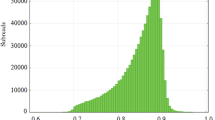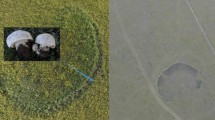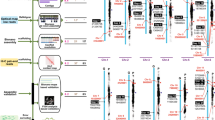Abstract
Macrofungus is defined as the fungus that grows an observable sporocarp. The sporocarps of many species are commonly called mushrooms and consumed by people all around the world as food and/or medicine. Most macrofungi belong to the divisions Basidiomycetes and Ascomycetes, which are estimated to contain more than 80,000 species in total. We report the draft genome assemblies of macrofungi (83 Basidiomycetes species and 7 Ascomycetes species) based on Illumina sequencing. The genome sizes of these species ranged from 27.4 Mb (Hygrophorus russula) to 202.2 MB (Chroogomphus rutilus). The numbers of protein-coding genes were predicted in the range of 9,511 (Hygrophorus russula) to 52,289 (Craterellus lutescens). This study provides the largest genomic dataset for macrofungi species. This resource will facilitate the artificial cultivation of edible mushrooms and the discovery of novel drug candidates.
Similar content being viewed by others
Introduction
The uncountable and diverse macrofungi species in the world are valuable resources for the discovery of novel drug candidates. For instance, a PTP1B inhibitor, (24E)-3,4-seco-cucurbita-4,24-diene-3-hydroxy-26,29-dioic acid, is extracted from the sporocarps of Russula lepida, and has potential uses in treating type-2 diabetes and obesity1. Metabolites of many Lactarius species have potential antitumor and antiviral activities2. Auricularia auricula polysaccharides were reported to have potent antioxidant activities against hydroxyl and superoxide radicals3. Despite the importance in drug discovery, the majority of macrofungi species could not be thoroughly researched in the laboratory partly due to the lack of reference genomes. So far, since a few macrofungi genomes have been reported4,5,6,7, many large fungal genome projects are in progress8,9,10. This reports the draft genome assemblies of 90 fungus, most of which are wild edible mushrooms (except Annulohypoxylon stygium, Tricholoma bakamatsutake, and Russula foetens). Our samples contained 83 Basidiomycetes species and 7 Ascomycetes species.
Result
Genome assembly and evaluation of the completeness of genome assembly
We used platanus to assemble all genomes11. The sizes of assembled genomes ranged from 27.4 Mb (Hygrophorus russula) to 202.2 MB (Chroogomphus rutilus). The contig N50 numbers of these assemblies were in the range of 2,846 bp to 697,803 bp. The scaffold N50 numbers of these assemblies were in the range of 3,350 bp to 1,760,261 bp. All detailed assembly benchmarks were summarized in Supplementary Table S1 and Supplementary Table S2. We also evaluated the completeness of the final assemblies using BUSCO12. The result shows that the proportions of complete BUSCOS of the 90 species were in the range of 69.3% to 98.6%. 78 fungal genomes had a complete BUSCO proportion larger than 80%. All related BUSCO results were shown in Supplementary Table S1.
Gene annotation
We used multiple methods to annotate the protein-coding genes for all 90 genomes, including de novo predictions and homology-based predictions. For the de novo predictions, we performed Augustus13 analysis on the repeat-masked genome with parameters trained from Coprinopsis cinerea, GenScan14, glimmerHMM15, SNAP16 analysis with parameters trained from Arabidopsis thaliana on the repeat-masked genome. For homology based predictions, we used the protein sets of eight fungal species for every macrofungus genome (Please see Supplementary Table S2 for details). All the reference protein sets were obtained from Ensembl fungi (http://fungi.ensembl.org/index.html).
The result shows that the numbers of the protein-coding genes were mostly in the range of 9,511 to 39,074. Craterellus lutescens had over 50,000 predicted protein-coding genes about 52,289. The average protein-coding gene lengths were in the range of 924 bp to 1,741 bp. Detailed information for each fungus was presented in Supplementary Table S2.
Gene family clustering analysis
To identify and estimate the numbers of potential orthologous gene families, we applied the OrthoMCL (v. 2.0.9) pipeline17 using standard settings (BLASTP E-value < 1e−5) to compute the all-against-all similarities. The result was summarized in Venn diagram format using a web tool (http://bioinformatics.psb.ugent.be/webtools/Venn). All results were shown in Fig. 1. We arbitrarily grouped close-related mushroom species together for the analyses and found that each group had about 3,000~4,000 shared gene families.
Phylogenetic Analysis
We then constructed phylogenetic trees for these macrofungi according to taxonomical divisions. For each phylogenetic tree, we used 8~10 reference fungi genomes. All single-copy orthologous genes identified in the gene family cluster analysis were used to construct a phylogenetic tree. MUSCLEv.3.8.31 with default settings was used to perform the multiple sequence alignments18. MrBayes19 was used to reconstruct phylogenetic trees. The result shown in Supplementary Fig. S1.
Notes on CAZymes
Carbohydrate-active enzymes (CAZys) include carbohydrate esterases, glycoside hydrolases (GHs), glycosyltransferases (GTs), and polysaccharide lyases (PLs). We annotated the putative CAZy genes in all mushroom genomes by hmmer3.120 against dbCAN-fam-HMMs.txt.v6 (http://csbl.bmb.uga.edu/dbCAN/21) and filtered the result with E < 1e-5. In general, Craterellus lutescens has a large number of CAZy genes compared with other species. Morchella eximia has a larger number of GH genes and Cantharellus appalachiensis has a larger number of GT genes than others except Craterellus lutescens.
Analysis of Microsatellites
Microsatellites, also known as simple sequence repeats (SSRs), are composed of 1 to 6 nucleotide repeats in tandem. These genomic features contain important information of phenotypic diversity and genome organization22. We used MISA23 to identify mono- to hexa-nucleotide microsatellite motifs by default parameters. The results are shown in Supplementary Table S3. The numbers of SSRs range from 1,222 (Laetiporus sulphureus) to 30,904 (Tuber calosporum).
Discussion
We believe this genome dataset will be a useful tool for various molecular investigations to promote biology-based medicine and agriculture research. It will also support the investigation of physiological characteristics, morphological differences, evolutionary, and metabolic analyses in comparative genomics, thereby providing evidence for population genetics of the many fungal species.
Method
Genomic DNA sequencing on Illumina platforms
All mushroom samples were obtained from the local fresh market in Yunnan and Sichuan provinces. To prevent contamination, we removed the surface with a sterile knife and took the middle part as the experimental material. We identified the mushrooms by observing the morphological characteristics and matching the ITS sequence against the database to determine the species. We provided the Mycobank accession numbers24 of all species in Supplementary Table S4, with which readers could get more information about the mushrooms in Mycobank.
About 400 mg sporocarp tissues from each sample were used to extract genomic DNA using the Plant Genomic DNA Extraction Kit DP320 (TIANGEN, Beijing, China). Paired-end libraries with insert sizes of 425 bp and 725 bp were constructed using the Next UltraTM DNA Library Prep Kit for Illumina (NEB, USA) according to manufacturer’s instructions, and subsequently sequenced on a HiSeq. 4000 platform (Illumina, USA) using the PE-150 module25. To improve the assembly quality, we filtered out the low-quality reads following these criteria: (1) Filter reads in which more than 5 percent of bases were N or poly A; (2) Filter low-quality reads in which more than 30 bases were low quality; (3) Filter reads with adapter contamination; (4) Filter reads with small size; (5) Filter PCR duplicates.
Estimation of genome sizes
For each macrofungus, clean reads obtained from the Illumina platform were subjected to 17-mer frequency distribution analysis with Jellyfish26. Analysis parameters were set at -k 17, and the final result was plotted as a frequency graph. Two distinctive modes could be observed from some distribution curves, suggesting a high degree of heterozygosity. We then used the following formula to predict the genome size: genome size = k-mer_Number/Peak_Depth. The predicted genome sizes ranged from 36 Mb to 301.4 Mb. This suggests that the sequencing data represents about 40 to 150-fold coverage of the genome. The detailed information for all 90 species is listed in Supplementary Table S5.
Genome assembly and Reapeat annotation
We used platanus to assemble all genomes with default parameters11. We compared the assembled genome and predicted genome in Supplementary Fig. S2 and evaluated the completeness of the final assemblies using BUSCO15 with the fungi gene set.
For the transposable element annotation, we used RepeatMasker and RepeatProteinMasker27 against Repbase (v.18.07) to identify known repeats in the genome. Tandem Repeat Finder28 was used to identified tandem repeats. In addition, we used RepeatModeler and LTR FINDER29 to identify de novo evolved repeats in the genome. The total length of repeated sequences of genome are in the rage of 1.34% to 94.7%. The detailed results were shown in Supplementary Table S2.
Gene annotation
For homology-based predictions: First, we used TBLASTN with parameters of ‘E-value = 1e−5’ to cutoff the query sequences. Then concatenated the result which corresponded to reference proteins and filtered low-quality records by Solar30 software. Genomic sequence of each reference protein was extended upstream and downstream by 2,000 bp to represent a protein-coding region. Use GeneWise software31 to predict gene structure contained in each protein region. Homology-based and de novo were merged to a comprehensive and non-redundant gene set by EVidenceModeler32.
Non-coding RNA annotation
We used tRNAscan-SE (version 1.31)33 software with default parameters for eukaryote to get tRNA annotation. We also used BLASTN with parameters of ‘E-value = 1e-5’ based on homology information of yeast rRNAs to get rRNA annotation. The miRNA and snRNA genes were predicted by INFERNAL software (http://infernal.janelia.org, version 1.1) against the Rfam database (Release 11.0)34. Detailed information was presented in Supplementary Table S2.
Data availability
The genome sequence have been uploaded in NCBI with the project ID PRJNA454572, Supplementary Table S6 provide the project ID of raw data in NCBI.
Material availability
Genomic DNA samples of all 90 species have been deposited in the collection of Yunnan Edible Mushroom Research Initiative of the Yunnan Agricultural University in China.
Change history
18 May 2020
An amendment to this paper has been published and can be accessed via a link at the top of the paper.
References
Liu, J. K. New terpenoids from Basidiomycetes. Russula lepida.Drug Discov Ther. 1, 94–103 (2007).
Feussi Tala, M., Qin, J., Ndongo, J. T. & Laatsch, H. New Azulene-Type Sesquiterpenoids from the Fruiting Bodies of Lactarius deliciosus. Nat Prod Bioprospect. 7, 269–273 (2017).
Fan, L. S., Zhang, S. H., Yu, L. & Ma, L. Evaluation of antioxidant property and quality of breads containing Auricularia auricula polysaccharide flour. Food Chem. 101, 1158–1163 (2007).
Martin, F. et al. The genome of Laccaria bicolor provides insights into mycorrhizal symbiosis. Nature. 452, 88–92 (2008).
Stajich, J. E. et al. Insights into evolution of multicellular fungi from the assembled chromosomes of the mushroom Coprinopsis cinerea (Coprinus cinereus). Proc Natl Acad Sci USA 107, 11889–94 (2010).
Martin, F. et al. Perigord black truffle genome uncovers evolutionary origins and mechanisms of symbiosis. Nature. 464, 1033–8 (2010).
Morin, E. I. et al. Genome sequence of the button mushroom Agaricus bisporus reveals mechanisms governing adaptation to a humic-rich ecological niche. Proc Natl Acad Sci USA 109, 17501–6 (2012).
Kohler, A. et al. Convergent losses of decay mechanisms and rapid turnover of symbiosis genes in mycorrhizal mutualists. Nat Genet. 47, 410–5 (2015).
Nagy, L. G. et al. Comparative Genomics of Early-Diverging Mushroom-Forming Fungi Provides Insights into the Origins of Lignocellulose Decay Capabilities. Mol Biol Evol. 33, 959–70 (2016).
Floudas, D. et al. The Paleozoic origin of enzymatic lignin decomposition reconstructed from 31 fungal genomes. Science. 336, 1715–9 (2012).
Kajitani, R. et al. Itoh T, Efficient de novo assembly of highly heterozygous genomes from whole-genome shotgun short reads. Genome Res. 24, 1384–95 (2014).
Simão, F. A., Waterhouse, R. M., Ioannidis, P., Kriventseva, E. V. & Zdobnov, E. M. BUSCO: assessing genome assembly and annotation completeness with single-copy orthologs. Bioinformatics. 31, 3210–2 (2015).
Stanke, M., Steinkamp, R., Waack, S. & Morgenstern, B. AUGUSTUS: a web server for gene finding in eukaryotes. Nucleic Acids Res. 32, W309–12 (2004).
Cai, Y., Gonzalez, J. V., Liu, Z. & Huang, T. Computational systems biology methods in molecular biology, chemistry biology, molecular biomedicine, and biopharmacy. Biomed Res Int. 2014, 746814 (2014).
Majoros, W. H., Pertea, M. & Salzberg, S. L. TigrScan and GlimmerHMM: two open source ab initio eukaryotic gene-finders. Bioinformatics. 20, 2878–2879 (2004).
Korf, I. Gene finding in novel genomes. BMC Bioinformatics. 5, 59 (2004).
Li, L., Stoeckert, C. J. & Roos, D. S. OrthoMCL: identification of ortholog groups for eukaryotic genomes. Genome Res. 13, 2178–003 (2013).
Edgar, R. C. MUSCLE: multiple sequence alignment with high accuracy and high throughput. Nucleic Acids Res. 32, 1792 (2004).
Yang, Z. PAML 4: phylogenetic analysis by maximum likelihood. Mol Biol Evol. 24, 1586–91 (2007).
Mistry, J., Finn, R. D., Eddy, S. R., Bateman, A. & Punta, M. Challenges in Homology Search: HMMER3 and Convergent Evolution of Coiled-Coil Regions. Nucleic Acids Research. 41, e121 (2013).
Yin, Y. et al. dbCAN: a web resource for automated carbohydrate-active enzyme annotation. Nucleic Acids Res. 40, W445–51 (2012).
Driscoll, C. A., Menotti-Raymond, M., Nelson, G., Goldstein, D. & Stephen, J. O. ’B. Genomic Microsatellites as Evolutionary Chronometers: A Test in Wild Cats. Genome Res. 12, 414–423 (2002).
Thiel, T., Michalek, W., Varshney, R. K. & Graner, A. Exploiting EST databases for the development and characterization of gene-derived SSR-markers in barley (Hordeum vulgare L.). Theor Appl Genet. 106, 411–22 (2003).
Robert, V. et al. MycoBank gearing up for new horizons. IMA Fungus. 4(2), 371–9 (2013).
Quail, M. A. et al. A tale of three next generation sequencing platforms: comparison of Ion Torrent, Pacific Biosciences and Illumina MiSeq sequencers. BMC genomics. 13, 341–354 (2012).
Marçais, G. & Kingsford, C. A fast, lock-free approach for efficient parallel counting of occurrences of k-mers. Bioinformatics. 27, 764–770 (2011).
Tarailo-Graovac, M. & Chen, N. Using RepeatMasker to identify repetitive elements in genomic sequences. Curr. Protoc. Bioinformatics. 4, 4.10.1–4.10.14 (2009).
Benson, G. Tandem repeats finder: a program to analyze DNA sequences. Nucleic Acids Res. 27, 573–580 (1999).
Xu, Z. & Wang, H. LTR_FINDER: an efficient tool for the prediction of full-length LTR retrotransposons. Nucleic Acids Res. 35, W265–W268 (2007).
Li, X. et al. Improved hybrid de novo genome assembly of domesticated apple (malus x domestica). Gigascience. 5, 35 (2016).
Birney, E. & Durbin, R. Using GeneWise in the Drosophila annotation experiment. Genome Res. 10, 547–548 (2000).
Haas, B. J. et al. Automated eukaryotic gene structure annotation using EVidenceModeler and the Program to Assemble Spliced Alignments. Genome biology. 9, R7 (2008).
Lowe, T. M. & Eddy, S. R. tRNAscan-SE: a program for improved detection of transfer RNA genes in genomic sequence. Nucleic Acids Res. 25, 955–64 (1997).
Nawrocki, E. P. & Eddy, S. R. Infernal 1.1: 100-fold faster RNA homology searches. Bioinformatics. 29, 2933–2935 (2013).
Acknowledgements
This work was supported by the National Science & Technology Pillar Program of Sichuan (2016NZ0042).
Author information
Authors and Affiliations
Contributions
Y.D., X.M., H.L., M.G., J.S. and W.H. designed the study. J.L., X.G., X.L., Q.L. and C.X. extracted genomic. J.Z. assembled the genomes. H.L., Y.G., S.D., L.K., W.S., P.W., R.S., Y.L. and Y.W. analyzed the data. H.L. and W.C. wrote the manuscript. All authors read and approved the final manuscript.
Corresponding authors
Ethics declarations
Competing Interests
The authors declare no competing interests.
Additional information
Publisher's note: Springer Nature remains neutral with regard to jurisdictional claims in published maps and institutional affiliations.
Rights and permissions
Open Access This article is licensed under a Creative Commons Attribution 4.0 International License, which permits use, sharing, adaptation, distribution and reproduction in any medium or format, as long as you give appropriate credit to the original author(s) and the source, provide a link to the Creative Commons license, and indicate if changes were made. The images or other third party material in this article are included in the article’s Creative Commons license, unless indicated otherwise in a credit line to the material. If material is not included in the article’s Creative Commons license and your intended use is not permitted by statutory regulation or exceeds the permitted use, you will need to obtain permission directly from the copyright holder. To view a copy of this license, visit http://creativecommons.org/licenses/by/4.0/.
About this article
Cite this article
Li, H., Wu, S., Ma, X. et al. The Genome Sequences of 90 Mushrooms. Sci Rep 8, 9982 (2018). https://doi.org/10.1038/s41598-018-28303-2
Received:
Accepted:
Published:
DOI: https://doi.org/10.1038/s41598-018-28303-2
This article is cited by
-
Basidiomycete non-reducing polyketide synthases function independently of SAT domains
Fungal Biology and Biotechnology (2023)
-
Lignin-degrading enzymes from a pathogenic canker-rot fungus Inonotus obliquus strain IO-B2
AMB Express (2023)
-
Genome Sequencing Highlights the Plant Cell Wall Degrading Capacity of Edible Mushroom Stropharia rugosoannulata
Journal of Microbiology (2023)
-
Systematic arrangement within the family Clitocybaceae (Tricholomatineae, Agaricales): phylogenetic and phylogenomic evidence, morphological data and muscarine-producing innovation
Fungal Diversity (2023)
-
The first two mitochondrial genomes for the genus Ramaria reveal mitochondrial genome evolution of Ramaria and phylogeny of Basidiomycota
IMA Fungus (2022)
Comments
By submitting a comment you agree to abide by our Terms and Community Guidelines. If you find something abusive or that does not comply with our terms or guidelines please flag it as inappropriate.




